Koi Hum Sa Kahan Novel By Shagufta Kanwal Complete PDF

| Attribute | Value |
|---|---|
| Novel Name | WaKoi Hum Sa Kahan (کوئی ہم سا کہاں) |
| Writer Name | Shagufta Kanwal (شگفتہ کنول) |
| Language | Urdu |
| File Format | |
| Size | 11.82 MB |
| Pages | 535 |
| Genre | Emotional, Romantic |
| Status | Complete |
| Main Characters | Mansha, Asfand, Dilawar, Safa |
Koi Hum Sa Kahan by Shagufta Kanwal is a powerful Urdu novel that explores deep-rooted feudal traditions, caste conflict, and forbidden love. With a strong emotional narrative and layered characters, this novel delves into how love struggles to survive in the rigid boundaries of power, pride, and generational hatred.
Story Overview
The story centers around Mansha, the younger sister of Dilawar, who has moved to the city to escape the oppressive rule of the Chaudhry family in their native village. Dilawar, an educated and self-respecting man, couldn’t tolerate being treated like a servant by the feudal lords. Their father was previously killed in a land rivalry, which further deepened Dilawar’s bitterness toward the village.
However, their grandparents still live and serve in the Chaudhry haveli, and Mansha, attached to them, secretly visits the village against her brother’s will. At the haveli, she unexpectedly meets Asfand, her childhood admirer and Dilawar’s friend. Unknown to her, Asfand has always loved her, but the feudal mindset makes this love story almost impossible.
Adding complexity is Safia Begum, Asfand’s authoritative grandmother and the matriarch of the haveli, who controls every decision. She strongly opposes women’s education, and in the Chaudhry household, girls are forbidden from studying.
As the story progresses, two love stories begin to unfold, Mansha and Asfand, and Dilawar and Safa (Asfand’s cousin). But both couples face societal boundaries, class differences, and the weight of generational enslavement and customs.
Themes Explored
- Feudalism vs. Freedom: The novel shows how young minds challenge centuries-old feudal values.
- Caste & Class Differences: It questions how love is judged by lineage, not emotions.
- Women Empowerment: Through Mansha, the story highlights a woman’s right to choose, learn, and love.
- Love vs. Legacy: Both love stories are tested against family pride and feudal honor.
Conclusion
Koi Hum Sa Kahan is a well-written and emotionally gripping novel that reflects the harsh realities of feudal culture while offering hope through love and resistance. Shagufta Kanwal masterfully weaves drama, romance, and societal critique into a story that feels both real and relevant.
Other Novels by Shagufta Kanwal:
